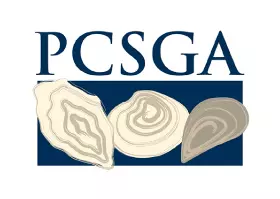
Twice a year, shellfish growers join forces with local growers, state agencies and non-profit organizations to remove debris from local beaches in South Puget Sound. In March and October, a force of 100 volunteers and 20 boats scour over 100 miles of shoreline for marine debris of all types. Debris is then transported by vessel to either of the two land-based sorting stations at Arcadia Boat Launch in Shelton and National Fish and Oyster in Nisqually.
Over the last 15 years, the shellfish industry has expanded, and yet the composition of debris collected during these cleanups remains fairly constant — with debris NOT related to shellfish aquaculture making up 80% of the collection. Of the small amount of shellfish gear recovered, about half is typically returned to shellfish grower’s farms or recycled. It is one of PCSGA’s primary goals to work with our members to minimize the amount of gear escaping from farms during storm events, and cleanup gear that enters our waterways.
“The PCSGA beach cleanup is great. Awesome to see how much the industry cares about the water and continually improving practices to reduce marine debris.” – Andy Gregory, Pollution Prevention Director, Puget Soundkeeper Alliance
Keeping our beaches clean is a group effort and shellfish growers acknowledge their role in taking care of the shorelines where they farm. The cleanups are a reminder for growers to continuously maintain the integrity of gear on farms and demonstrate their commitment to protecting and preserving the ecosystem. Fees to dispose of the debris are raised at PCSGA’s annual community shellfish celebration, SLURP in Olympia.
Plastics/Recycling
If you have plastics that you would like to recycle, call the PCSGA office at 360-754-2744. We work with a local recycling plant in Tacoma, WA who recycles plastics used in aquaculture. We also work with a trucking company in Tacoma who will drive out to your farm, pick up your used plastics, and haul them to the recycler in Tacoma.
Solid and Hazardous Waste Management
Solid waste, such as netting, stakes, tags and bags, are generated in the normal course of farm operations and may be introduced into the environment accidentally as a result of weather or sea conditions or as ropes and culture gear age and break down. Plastic pollution in the ocean is a major international issue. It is a concern for shellfish growers in particular in light of emerging science on the potential effects micro and nano plastics may have on animal and human health. Many types of shellfish culture involve the use of considerable ropes and plastic gear. Farmers must ensure they are using gear designed to withstand the elements it is being deployed in and that it is being retired and recycled or disposed of properly before it degrades and contributes to plastic pollution. Farmers must attempt to minimize generation of waste by employing responsible waste reduction, recycle, and control measures.
Suggested strategies for minimizing marine debris:
- Minimize waste generation to the extent possible, practicing the principles of reduction, reuse, recycling and recovery.
- Purchase materials with a long lifespan or which are reusable or recyclable.
- Use only gear designed to withstand the elements is it being deployed in, and that it is retired and recycled or disposed of properly before it breaks down in the environment.
- Participate in volunteer clean-up efforts of the waters and coastline surrounding farms.
- Encourage suppliers and manufacturers of shellfish equipment and packaging to develop and adopt recycling and disposal plans for the products they sell.
- Encourage other marine resource user groups to be responsible in the collection and disposal of garbage and wastes.
Best Management Practices: Rope Fragments
In addition to industry Environmental Codes of Practice, follow these Best Management Practices to ensure broad employee awareness regarding rope fragments.
When on the farm
- Avoid transplanting oysters with visible rope fragments
- Refrain from cutting rope into smaller segments during harvest
- Consider chase crews to follow vessels to retrieve any rope fragments when spreading shell
- Monitor for rope fragments before accepting shell delivery from processing plants
- Avoid contaminated shell where it could be accidentally reused
- Dispose of any rope fragments found at farm sites
When at the processing facility
- Clean oyster shells via washing and tumbling
- Utilize available mechanical shell-rope separator technologies
- Assign a separate pile for oyster shell with rope fragments
- Implement steps to remove rope fragments when cultch is bagged
When storing shells
- Ensure all shell is clean and free of rope fragments when creating new shell piles
- Assign crews to rake and remove rope fragments from shell piles
- Avoid using old shell piles that contain rope fragments
- Dispose of contaminated shell and cultch bags to avoid accidental reuse
Microplastics in the Media
Sandra Shumway, National Shellfisheries Association – The Microplastics and Shellfish Media Frenzy: Stop the Train, We Want to Get Off

